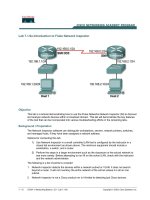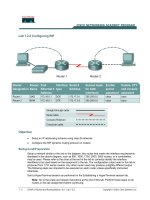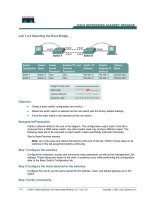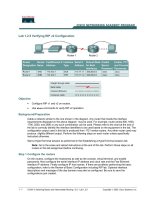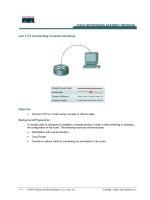Lab 7.1.2 Waveform Decoding
Bạn đang xem bản rút gọn của tài liệu. Xem và tải ngay bản đầy đủ của tài liệu tại đây (64.38 KB, 2 trang )
1 - 2 CCNA 1: Networking Basics v 3.0 - Lab 7.1.2 Copyright 2003, Cisco Systems, Inc.
Lab 7.1.2 Waveform Decoding
Objective
The purpose of this lab is to integrate knowledge of networking media, OSI Layers 1, 2, and 3, and
Ethernet, by taking a digital waveform of an Ethernet frame and decoding it. Specifically, students
will do the following:
• Review numbering systems, OSI concepts, and encoding methods as background from Module
1.
• Learn to decode the waveform back into binary, reorder the binary, and identify Ethernet field
boundaries from Module 2.
• Decode the Ethernet Length/Type field, locate and read RFCs, and decode Layer 3 of the
waveform from Module 3.
• Use a Protocol Analyzer from Module 4.
Background / Preparation
As a student of networking, there are many new concepts to be learned about:
• The OSI model
• Networking media and signals
• Ethernet
• The TCP/IP protocols
Network administrators, technicians, and engineers study and troubleshoot a network using Protocol
Analysis software. Protocol Analysis software allows the capture and interpretation of frame-level
data, which is crucial for understanding what is happening on a live and perhaps troublesome
network. Hand-decoding the signal gives more insight into what the software is doing automatically.
Therefore, this lab provides an important foundation for future learning of network troubleshooting.
A Digital Oscilloscope was attached to an Ethernet 10BASE2 coaxial cable to capture actual
Ethernet waveforms. Although it is possible to capture waveforms on 10BASE-T and 100BASE-TX
twisted pair media, the coaxial cable gives the cleanest and most readable waveform data. This data
is available from the instructor. Decoding the waveform is a crucial step in understanding how
networks operate.
For the first part of the lab, all that is needed is this lab printout and the printout of the waveform for
students to write on as they decode. The last task of the lab involves the use of a Protocol Analyzer,
which is Fluke Protocol Inspector or the equivalent.
Note: This lab is over 20 pages long and includes excellent supplemental sections on the
following:
• Numbering systems, which include binary, decimal, and hex
• The OSI 7-Layer model with real-world examples
• Signaling and Encoding methods (Ethernet Manchester)
2 - 2 CCNA 1: Networking Basics v 3.0 - Lab 7.1.2 Copyright 2003, Cisco Systems, Inc.
The lab can be downloaded from the local Academy server at the institution with Version 3.0 of the
curriculum or from the Cisco Academy Connection website. The Ethernet waveform for decoding will
also need to be downloaded. Check with the instructor for help in obtaining the lab and waveform.



